Food Waste Increase in the Pandemic
Air Date: Week of May 15, 2020
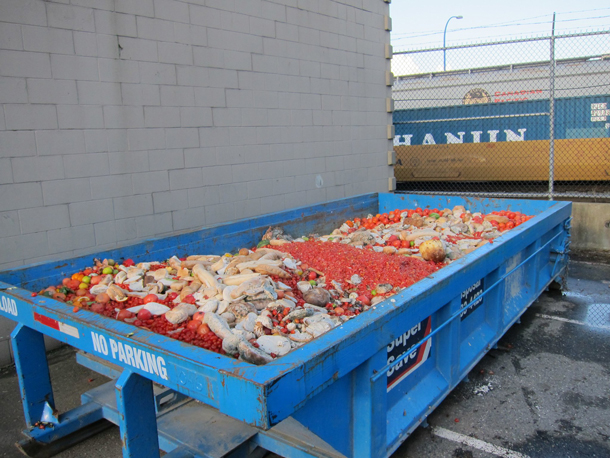
Between food that goes to waste in distribution and in-home refrigerators, a third of all food produced is wasted. (Photo: Stephen Rees, Flickr CC BY-NC-ND 2.0)
Long before the COVID-19 disruptions forced dairy farmers to dump swimming pool quantities of milk into fields, a third of all food produced was going to waste, with huge consequences for hunger and the climate. John Mandyck, the CEO of the Urban Green Council, joins Host Steve Curwood to discuss how improving distribution, consumer habits, and “best-by” labels can reduce food waste, feed the hungry, save money and reduce carbon emissions.
Transcript
CURWOOD: Around the world more than a one-third of all food is wasted. In less affluent countries a lot of food becomes spoiled on the way to market, but in the US and other rich economies most food is thrown out at home because it’s rotted in the fridge or on the counter. And the numbers are huge. On a yearly basis food waste accounts for more than 3 gigatons of carbon dioxide, about a third of the human CO2 contribution to climate disruption. And with the closure of many restaurants and schools amid the pandemic, interruptions in food supply chains have led to even more food waste. John Mandyck is CEO of the Urban Green Council and co-author of the book Food Foolish: The Hidden Connection Between Food Waste, Hunger, and Climate Change. He joins me now. John Mandyck, welcome back to Living on Earth!
MANDYCK: Hey, Steve, it's great to be back on the program.
CURWOOD: Wonderful to have you. We're seeing reports that say gallons of milk are being dumped and fields and fields of vegetables are being plowed under. What's going on?
MANDYCK: You know, Steve, when I see farmers having to dump milk or plow under vegetables, I think about three big things. First thing I think about is that this shows the short term balance in our food supply. Disruption travels very fast. Think about the egg that was served in the restaurant. That egg got to that restaurant just one or two days ago. If the restaurant closes, the chicken doesn't know that. The eggs keep rolling. And so the farmer is left with a problem that he has to deal with. And so that's what we're seeing with the short term balance in our food supply. The second thing I think about is the lack of refrigerated storage for food banks. This has always been the case-- it's always been a problem. If food banks had proper refrigerated storage, all this milk that's being dumped under could have gone somewhere. And that's the plight that the farmer--has farmers say, I wish I had someplace I could deliver this milk. And the third thing this points out is that we're actually pointing the finger in the wrong place.
CURWOOD: Oh?
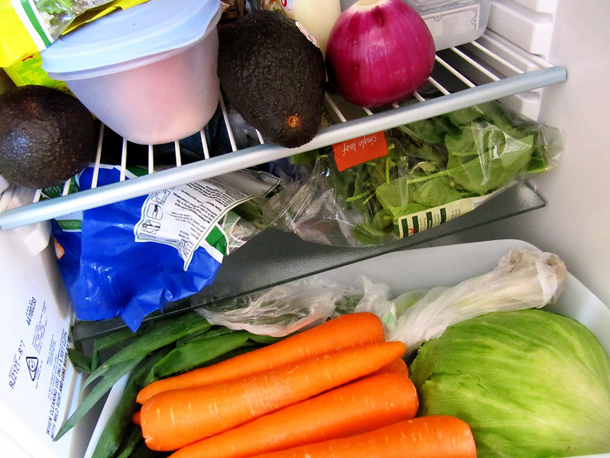
In the United States, most food waste happens right in our own refrigerators. (Photo: chinwei, Flickr CC BY-NC-ND 2.0)
MANDYCK: You know, our food production and distribution in the United States is very well calibrated. Our problem is with consumers in the United States. The number one place we waste food in the United States is at the household level. We did that before the pandemic. We're doing that during the pandemic and we will do that after the pandemic. Food is the number one item in US landfills. That didn't come from the farmer --that came from our waste bins.
CURWOOD: One of the interesting aspects of the COVID crisis and the isolation associated with it is that I think more of us are cooking. To what extent do you think cooking at home will raise awareness for people about how much food has been historically wasted at home?
MANDYCK: I think it will. I mean that the closer we can become connected to our food, the better we'll understand it. You know, for a long time, we've thought that grocery stores were these magical places where, you know, we buy yogurt, we don't use it, we throw it away, we go back to the grocery store, and guess what the yogurt is back on the shelf like it magically appeared. And so we bought it again. You know, the pandemic is showing us with shortness of supply chains that well maybe grocery stores aren't the magic places that we thought they were because by the way, the yogurt wasn't there when you went back. And so hopefully it is bringing people closer to their food, starting to question, Well, why wasn't the yogurt there? Well, there's a long distribution chain to get the yogurt there. And so the closer we come to our food, I think the more respect we'll have for where it came from, how it got to our table and how we actually should cherish it more.
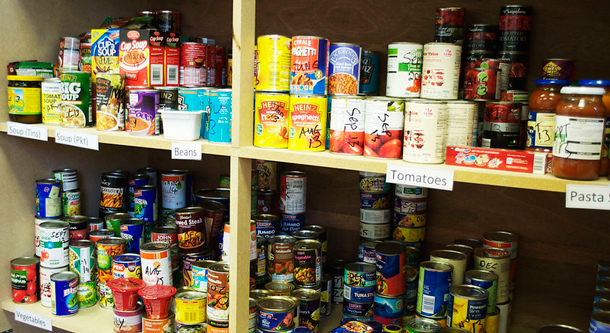
Food banks have limited refrigerator space, so excess milk, eggs or other highly perishable foods must often be disposed of rather than distributed to hungry families. (Photo: Staffs Live, Flickr CC BY-NC 2.0)
CURWOOD: So what about the whole notion put by more people, I don't know how many more, are gardening out there? And it's harder to throw away that lettuce that you've grown with weeding all the stuff you have to do, as opposed to just simply having picked it up at the store. To what extent do you think that making food closer to home might help with this food waste problem?
MANDYCK: I think it does. If you invest the time to grow your own food in the backyard, you literally have sweat and tears invested in your food supply. So I think that helps, but it points out another issue. I don't know if you've ever tried to grow zucchini in your backyard. The zucchini comes in and on and off switch. And so you wait all season and then you get two bushels of them.
CURWOOD: Yeah, some of them are the size of baseball bats as well if you're not careful.
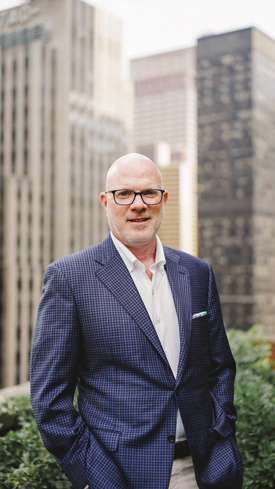
John Mandyck is the CEO of the Urban Green Council and author of Food Foolish: The Hidden Connection Between Food Waste, Hunger and Climate Change. (Photo: courtesy of John Mandyck)
MANDYCK: That's right. And so I know in my house, we can't eat all of those. So it really underscores the issue in our food system, is that there's literally a bounty of riches when the harvest comes and so you have to find a way to get rid of that zucchini. Otherwise you're gonna throw it away, too, right? So you're making zucchini cakes, you're shredding it, you're freezing it. There's only so much that you can do and then you start your own food distribution system by giving it to your sister, your mother, your neighbor. But that too helps underscore the bigger picture that we have with our global food supply.
CURWOOD: So what do you recommend that we do as a nation and as individuals to reduce food waste then?
MANDYCK: Well, you know, as a nation, our number one issue is at the consumer level. That's where we're throwing away most food. It's the same in Europe, it's the same United States, it's really a rich country dilemma because we can afford to do it. Food is relatively inexpensive in the United States. And if we throw away the 99 cent yogurt because we were confused about the date label, we simply go back and get another 99 cent yogurt. So we have to have consumer education and awareness to understand the scale and consequences of what happens when we throw away that food. We have to have public policies that encourage us not to do that. And that means encouraging date labels that are rational and makes sense. This has happened in Europe. There's been strong campaigns over the last decade to encourage consumers to waste less food. And we've seen that those have worked. We need those campaigns in the United States. If you look globally, though, two thirds of all the global food supply is lost at that production and distribution level. This is an emerging economy problem where food rots in poor transportation networks, it rots in open air markets, it rots in wet markets in China, which is relevant to the pandemic that we're having today. And so we have to find ways to modernize that production and distribution system in emerging economies if we really want to tackle the issue on a global level.
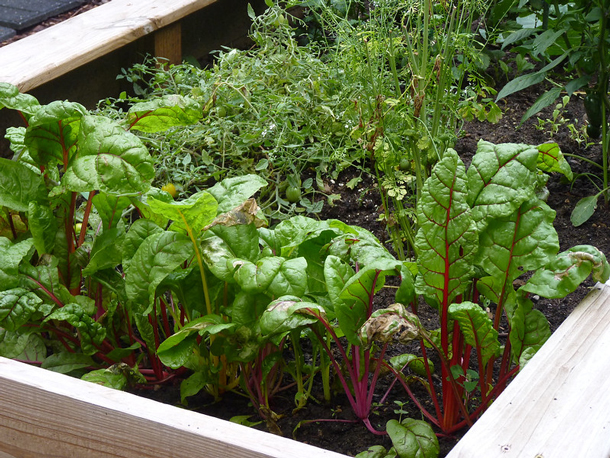
Self-isolation has many of us growing vegetables, cooking more and getting a little more in touch with our food. (Photo: normanack, Flickr CC BY 2.0)
CURWOOD: So what can we learn from other countries that have tried to tackle food waste?
MANDYCK: I'll point to two. In the United Kingdom, they started a consumer campaign called Love Food Hate Waste, where environmental organizations and hunger organizations partnered with the grocery stores, and the campaign has gone well. Over the last decade, they tell us that they've reduced household waste by 20%, which is a huge improvement. So that works well. France is a good case study in a different direction. A few years ago, France passed a law that bans supermarkets from throwing away food that is otherwise good to eat. Now, that sounds like a great policy that that sounds like it makes a lot of sense. But we can actually learn a lot from the French law. What happened is the supermarket said, okay, we can't throw away the food, we'll deliver him to the food banks. So if you run a small food bank in a small French village, one morning, you come to work and you could have three boxes of apples. That's great. You're going to distribute three boxes of apples to those in your village that you know they need them. The next morning, you come to work you find you have a truckload of eggs. What are you going to do with a truckload of eggs? You don't have the refrigerated capacity that we talked about. You don't have the distribution system, you can't get them out fast enough. So what happened in a inverse way is that food banks were starting to throw away the food. And, you know, kind of standing up and saying what just happened here? And so it's really questioned the role of policy policies needed. But we have to understand the unintended consequences of those policies. And the French law was, as has been a great lesson to the world.
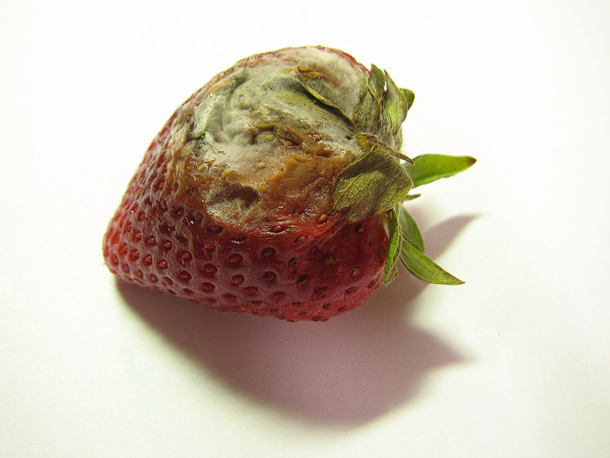
The strawberry that molds in your fridge carries an additional carbon load from all the transport, refrigeration, and packaging it took to get from the field to your home. (Photo: Kevin Payravi, Wikimedia Commons CC BY-SA 3.0)
CURWOOD: What's the impact of all this food waste on our climate do you think?
MANDYCK: Well food waste is, to me one of the sleeping giants of climate change. If you measure the carbon footprint of all the food that we lose or throw away each year, and we measure it as a country, it would be the world's third largest emitter of greenhouse gases. And so we need consumers to understand that particularly in the United States to help change consumer behavior that when we throw an item in the landfill, we just threw a ton of carbon in the landfill. An example is a strawberry. Steve, you and I are on the East Coast right now. If we eat a strawberry today, it came to us from California. It took a lot of carbon to prepare to grow that strawberry. The farmer had to go out in the field with a tractor. He had to plow the field under, he had to plant the strawberry, he had to water the strawberry, use a lot of water. Then he had to harvest a strawberry. Using carbon he had to bring the strawberry from the field into a packaging place which burned electricity. We took plastic which is carbon based and wrapped it in plastic then we put it on a truck and we brought it across the United States burning carbon. It got to the your grocery store, it sat on the shelf, the store is burning carbon waiting for you to come. Maybe you got in your car and burn carbon to go get the strawberry, brought it back you put it in your refrigerator which is plugged in burning carbon and then you forgot to eat it and it went bad and it got moldy and you threw it away. It would have been better to throw the strawberry away in the field from the carbon standpoint because it was fully carbon loaded when it got to you the consumer. And so we need to understand that it's not just throwing away the strawberry. It's throwing away all the carbon that went into getting the strawberry to you and to me.
CURWOOD: John Mandyck is CEO of the Urban Green Council. He's also co author of the book Food Foolish: The Hidden Connection Between Food Waste, Hunger and Climate Change. Thanks so much, John, for taking the time with us today.
MANDYCK: Steve, it's been great to be on the show.
Links
NYTimes | “Dumped Milk, Smashed Eggs, Plowed Vegetables: Food Waste of the Pandemic”
Living on Earth wants to hear from you!
Living on Earth
62 Calef Highway, Suite 212
Lee, NH 03861
Telephone: 617-287-4121
E-mail: comments@loe.org
Newsletter [Click here]
Donate to Living on Earth!
Living on Earth is an independent media program and relies entirely on contributions from listeners and institutions supporting public service. Please donate now to preserve an independent environmental voice.
NewsletterLiving on Earth offers a weekly delivery of the show's rundown to your mailbox. Sign up for our newsletter today!
 Sailors For The Sea: Be the change you want to sea.
Sailors For The Sea: Be the change you want to sea.
 The Grantham Foundation for the Protection of the Environment: Committed to protecting and improving the health of the global environment.
The Grantham Foundation for the Protection of the Environment: Committed to protecting and improving the health of the global environment.
 Contribute to Living on Earth and receive, as our gift to you, an archival print of one of Mark Seth Lender's extraordinary wildlife photographs. Follow the link to see Mark's current collection of photographs.
Contribute to Living on Earth and receive, as our gift to you, an archival print of one of Mark Seth Lender's extraordinary wildlife photographs. Follow the link to see Mark's current collection of photographs.
 Buy a signed copy of Mark Seth Lender's book Smeagull the Seagull & support Living on Earth
Buy a signed copy of Mark Seth Lender's book Smeagull the Seagull & support Living on Earth

